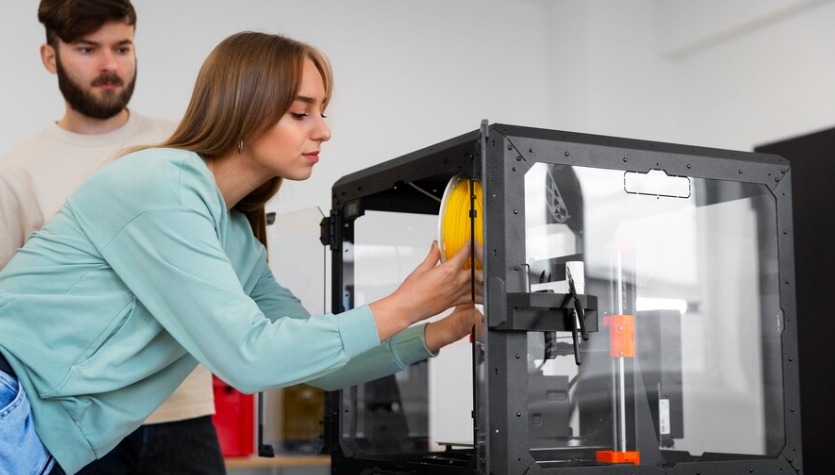From being a concept for futuristic kitchen fantasies, 3D food printers have developed into a workable, useful appliance in the contemporary home. These gadgets, which were once thought to be a luxury only accessible to commercial kitchens or tech-savvy chefs, are now accessible to anybody with an interest in culinary innovation. 3D food printers provide a new degree of artistic control over food preparation by using foods-safe pastes, and gels, and even chocolate. Intricate, personalized designs that surpass the capabilities of conventional cooking have sparked enthusiasm in home kitchens. They promise efficiency, convenience, and culinary creativity, but the question still stands: are they really worth the money, or are they just another piece of fancy equipment that will end up in the back of the pantry?
The potential of a 3D food printer is essentially limitless. Home cooks have the opportunity to experiment with their culinary creations, from customized cakes to edible sculptures. These devices also offer the chance to tailor meals to meet specific nutritional requirements for people with dietary limitations or health-conscious lifestyles. Businesses that provide products that enable 3D food printing in the home, such as XYZprinting and Cocoa Press, are at the forefront of this expanding market. But like any new technology, there are things to think about, like what these gadgets’ limitations are. How easy are they to use? Perhaps most importantly, are they merely a novelty with little practical application, or do they actually provide the functionality they claim to?
| Feature | Details |
|---|---|
| Printer Model | XYZprinting Food Printer |
| Print Capability | Prints cookies, cakes, and other decorative elements. |
| Material | Edible food gels, icing, and pastes. |
| Price | Starts at $600 |
| Best For | Baking enthusiasts and hobbyists |
| Website | CNET |
For instance, the XYZprinting Food Printer is a multipurpose model made with bakers in mind. It offers an enjoyable and effective method of printing food designs, such as cakes and cookies, with fine detail that might be challenging to accomplish by hand. Even though it’s reasonably priced, the printer needs certain food ingredients, like icing and edible gels, which might not be easily found at your neighborhood supermarket. Home users may incur additional expenses as a result. Nonetheless, the XYZprinting model provides exceptional value for hobbyists and professional bakers wishing to step up their game with precise designs.

However, the growing demand for personalized chocolate creations is catered to by the Cocoa Press 3D Chocolate Printer. With the help of this machine, people with a sweet tooth can make custom, one-of-a-kind chocolates. The Cocoa Press offers a remarkable level of versatility, whether you’re printing intricate cake decorations or personalized chocolate pieces. The Cocoa Press is a more specialized product for individuals who are serious chocolate lovers or small business owners wishing to expand their product lines, though, because it is significantly more expensive ($1,499 for the base model). For individuals with technical expertise, its more intricate setup and assembly procedure is a game-changer, but it may put off casual buyers.
3D food printers aren’t flawless, despite their popularity. These gadgets are only in charge of forming food into complex shapes; they are not made to cook food in the traditional sense. Food usually still needs to be cooked using conventional techniques, like baking or cooling, after printing. For those anticipating a completely automated, one-stop cooking solution, this additional step may be a major turnoff. Another layer of complexity is added by the requirement for specialized materials that might not be readily available in nearby stores.
The benefits and drawbacks of a 3D food printer need to be carefully considered before deciding if it’s the right choice for your kitchen. For those who are health-conscious or work as professional cake decorators, the ability to create personalized, elaborate food designs is a huge plus. Because of the great degree of creative control these printers provide, users can customize their food in ways that are not possible with conventional techniques. However, some people may find these devices prohibitively expensive due to their specialized materials. Many people may view these machines as novelty items that are used infrequently rather than as regular kitchen appliances.
Nevertheless, the 3D food printing market is expanding quickly, and as new technologies are developed, it is probable that more approachable and simple to use models will be made available. The market for 3D food printers is expanding due to advancements in the technology as well as the growing desire for food personalization. These developments are expected to continue influencing the food industry. For example, it is now feasible to order cookies with personalized logos or to print edible cake decorations with extremely complex designs.
This trend toward more individualized and customizable food preparation is not merely a fad; rather, it represents a change to cooking that is more practical, sustainable, and effective. Chefs and bakers are currently experimenting with 3D food printers in the workplace to produce creative new recipes and cutting-edge designs. These printers are expected to become more prevalent in home kitchens in the upcoming years, both for their innovative potential and for their capacity to expedite food preparation and cut down on waste.
